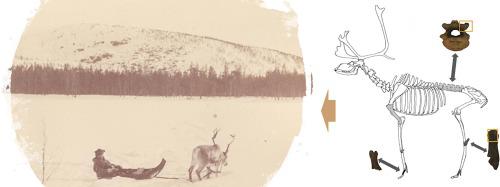Journal of Anthropological Archaeology ( IF 2.312 ) Pub Date : 2021-04-21 , DOI: 10.1016/j.jaa.2021.101303 Anna-Kaisa Salmi , Mathilde van den Berg , Sirpa Niinimäki , Maxime Pelletier

|
The domestication of the reindeer among the Sámi of Northern Fennoscandia is a pressing question for the archaeology of the area and has wider relevance to animal domestication studies globally. Despite considerable research activity, many details of reindeer domestication and early reindeer management remain unclear. This paper explores the use of draught reindeer in early Sámi reindeer herding and the implications for understanding reindeer domestication and early reindeer herding strategies. Faunal assemblages from three Sámi dwelling sites in Northeastern Fennoscandia (AD 1300–1800) were subjected to radiocarbon dating and analysis of palaeopathological lesions, entheseal changes and osteometric measurements. The results suggest that working reindeer were present in the archaeological assemblages from AD 1300 onwards. This is the earliest direct evidence of draught reindeer use by the Sámi. It predates the earliest unequivocal historical sources on draught reindeer use, and confirms the hypothesis that draught reindeer were important in early reindeer herding. Our results show that that small-scale reindeer herding was integrated into the subsistence strategy of the Sámi of Northeastern Fennoscandia earlier than previously suggested. Furthermore, the results imply that training and working together with reindeer were ways of constructing the domestication relationship between the Sámi and reindeer.
中文翻译:

东北Fennoscandia AD 1300及以后的萨米人中驯化驯鹿经济的最早考古证据
驯鹿在北芬诺斯坎迪亚北部的萨米人的驯化是该地区考古学面临的紧迫问题,并且与全球动物驯化研究具有更广泛的联系。尽管开展了大量研究活动,但驯鹿驯化和早期驯鹿管理的许多细节仍不清楚。本文探讨了驯鹿草稿在萨米早期驯鹿放牧中的用途,以及对了解驯鹿驯化和早期驯鹿放牧策略的意义。来自东北芬诺斯坎迪亚(公元1300–1800年)三个萨米人居住地的动物群进行了放射性碳年代测定和古病理学损害分析,肠黏膜变化和骨测量。结果表明,从公元1300年开始,考古组合中就出现了驯鹿。这是萨米人使用驯鹿草稿的最早直接证据。它早于关于驯鹿使用的最早明确的历史资料,并证实了关于驯鹿吃草对早期驯鹿放牧很重要的假设。我们的研究结果表明,小规模的驯鹿放牧比以前的建议更早地被纳入东北芬诺斯堪迪亚州萨米人的生存策略。此外,结果暗示驯鹿的培训和合作是在萨米人和驯鹿之间建立驯化关系的方式。我们的研究结果表明,小规模的驯鹿放牧比以前的建议更早地被纳入东北芬诺斯堪迪亚州萨米人的生存策略。此外,结果暗示驯鹿的培训和合作是在萨米人和驯鹿之间建立驯化关系的方式。我们的研究结果表明,小规模的驯鹿放牧比以前的建议更早地被纳入东北芬诺斯堪迪亚州萨米人的生存策略。此外,结果暗示驯鹿的培训和合作是在萨米人和驯鹿之间建立驯化关系的方式。



























 京公网安备 11010802027423号
京公网安备 11010802027423号